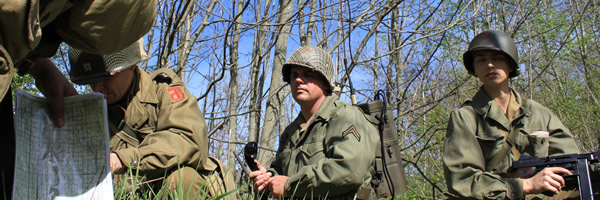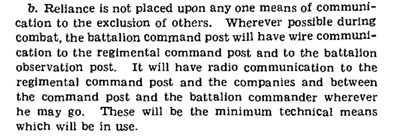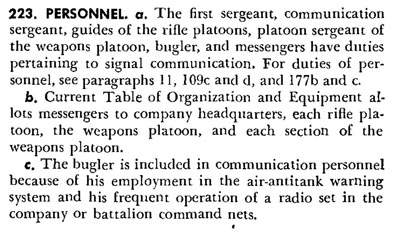Tableau Number 2
The SCR300 Radioman
Date: April 2013
Author: Pat Costa - 88th ID & 5th Rangers Dog Company
90th IDPG Editors - Chris Guska, Lee Mudd, Mike Ellis
What is a SCR-300?
Per TM 11-242 Radio Set SCR-300-A"Radio Set SCR-300-A Consists of an 18-tube, low-power, dry battery operated, portable radio receiver and transmitter and accessories. It is designed for frequency-modulated, two-way communication over short distances. It is primarily intended as a walkie-talkie for foot combat troops. However, it is also readily adaptable for fixed-station use. The complete radio installation weighs only 38.23 pounds with Battery BA-70, or 32.23 pounds with Battery BA-80."
The SCR-300 literally stands for Signal Corps Radio with 300 being the model number. Using this term refers to the entire unit.
Getting the Message Through, A Branch History of the U.S. Army Signal Corps, CENTER OF MILITARY HISTORY, UNITED STATES ARMY, WASHINGTON, D.C., 1996, Pg. 172
The term BC-1000 means basic component and refers to only the top part of the unit that houses all the tubes and electronics.
The term Battery Case (CS-128-A) refers to the bottom part of the unit.
The terms SCR-300 and BC-1000 are used interchangeably in this article.
This radio was known colloquially at the time as the "Walkie Talkie"
At what level was the SCR-300 used?
During World War II the SCR-300 radio was used primarily between companies, from companies to battalion, and from battalion to regiment.
(Pg. 55-56, FM 7-24 Communication in the Infantry Division)
Although FM 7-24 Communication in the Infantry Division states that radios like the SCR-300 could be used between a company and its platoons, it was not used primarily for intra-company communications.
Communications at the platoon level typically utilized the SCR-536 ("Handie-Talkie").
Communication at the company and battalion level typically utilizied the SCR-300.
Communication at the regimental level typically utilized the SCR-694
SCR-300, SCR-536, SCR-694, who used what and where?
Rifle companies operated as a part of a battalion communications net.
SCR-300 radios were distributed to the four infantry companies of the battalion as well as the supporting units of the regiment, such as the I&R platoon, cannon and anti-tank companies.
Radios vs. Runners & Wire?
We often view radios and other means of communications through our modern perspective, be it our experiences with modern radios or movies we've seen.
Radios at the time, while making great strides in capability and effectiveness, were not entirely reliable. With this experience, the Signal Corps and the Army at large did not build centralize communications around radios. The radio was just one of several modes of communication to be utilized situationally.
(Paragraph 56, FM 7-20 Rifle Battalion, September 28, 1942)
Employment of radios was dependent on the mission and only until the division’s or corps' wire units could arrive to establish a communication network based on wire, not radio.
"Despite new developments, the Signal Corps still relied upon older electrical items such as the field telegraph set TG-5 (buzzer, battery, and key), the field telephone EE-8 (battery powered), and a sound-powered phone TP-3 requiring no battery."
Getting the Message Through, A Branch History of the U.S. Army Signal Corps, CENTER OF MILITARY HISTORY, UNITED STATES ARMY, WASHINGTON, D.C., 1996, Pg. 276
Units would often rely on runners to deliver messages until wire could be set up. One should think of radios as communications of convenience or last resort.
Difficulties of Radio
Throughout the war, the Army had difficulty training specialized radio operators and having combat troops use the radios efficiently.
Men with specialized technical training on radios were not allocated by T/O&E to levels below the Battalion Headquarters Message Center, Radio and Visual Section.
Radios of the time, the SCR-300 included, were quite inefficient and troublesome when compared to today's communication equipment. Unless you had a good clear day, good line of sight (perhaps standing on higher ground or in very close contact of less than one mile) you might not get the message through.
(TM 11-242 Radio Set SCR-300-A, February 1945. Pg. 18)The radios also had a tendency to break down or exhaust batteries.
Experiences gained through utilizing and servicing the SCR-300 in the front lines were often short-lived due to high attrition rates among front line infantrymen. Some units in the ETO experienced 200-500% turnover of riflemen during their time in combat.
Who Carried the SCR-300:
While the radio itself was loaned from the battalions' stock, no operator was included. It was left to the company commander to appoint a radio operator. While this could have been the assigned communications sergeant (who was responsible for the function of the radio as part of the battalion net), it more likely would have been the company bugler, a carbine-armed private assigned directly to the company's Command Group. Also from the Command Group, one of three assigned messengers or 17 assigned basic-duty ("Basics") privates could have been selected as the commander's radioman.
(Paragraph 223, FM 7-10 Rifle Company, Infantry Regiment, March 18, 1944)
Conceivably, this duty may have been rotational; an opportunity to get from a rifle squad for a short respite in "the rear," or to move from the relative safety of the company command post forward to the CO's side for a few days. As rifle companies in contact frequently suffered heavy casualties and were rarely anywhere near full strength, the exact T/O&E position occupied by the SCR 300 operator was liable to considerable instability.
On to Section 2 - Notes from the manuals on equipment
Introduction
Section 1: By the book - TO&E (you are here)
Section 2: Notes from the manuals on equipment
Section 3: Original Photographs - Key Observations
Section 4: Notes on Training and Use
Section 5: Putting it together- Modern Interpretation
Section 6: Adapting the SCR300 for Reenactment Use
90th IDPG Original Research







